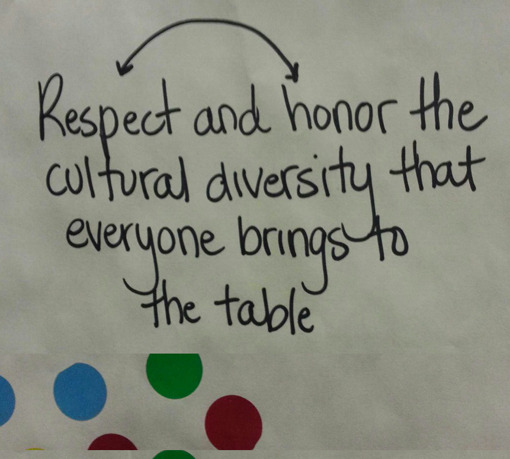
Good facilitation is often reflected in crowd participation. In many cases the one person most comfortable with speaking in public is the loudest at meetings, overshadowing others who may have equally as valuable ideas but are too shy to share them. When working with large groups of people to do visioning or problem solving, choosing the right discussion format can ensure participation from the majority of your group. Below we have assembled various discussion formats from various popular education practices.
###Question lead large group discussion
- Choose a framing question to post on the wall.
- The facilitator guides the group discussion beginning with the framing question.
- Facilitator guides group responses to other questions that might emerge from the leading question.
*This works best when the facilitator is able to synthesize peoples thoughts and relate them to each other and then back to the big question being asked.
###Think - Pair - Share
Step 1: Create a prompt that is connected to the goal of the meeting.
Step 2: Ask individuals to write a response to that prompt.
Step 3: Have the group break up into pairs to share their responses.
Step 4: Regroup and have each group share main points of their discussion.
Step 5: Ask people to discuss what ideas stuck out and why.
*This format is great way to get people who are unfamiliar with each other to work together. This also ensures that each member of the meeting is thinking and participating because everyone is asked to share their ideas with someone else in the group.
###Silent Consultation
Step 1: Identify major questions that need to be discussed or explored.
Step 2: Create four questions that encompass the main ideas that need to be discussed.
Step 3: Write each question on a large sheet of paper and place them in 4 areas around the room.
Step 4: Ask each participant to go around the room and write their responses/ ideas on each sheet of paper that has a question.
Step 5: Have the large group break up into four groups, one for each question that was asked.
Step 6: Have each group discuss the responses to the questions and create a summary of what was suggested, merging similar ideas.
Step 7: Have each group share their summary to the larger group.
Step 8: Facilitate the large group into figuring out next steps with each question.
*This is a great discussion format for breaking complex ideas or problems into manageable chunks of work that can be distributed amongst the group. This also is a great way to generate ideas for projects that include several perspectives.
###Break-Out Groups with Gallery Walk
Step 1: Divide the group into smaller groups to discuss responses to a reading or a question.
Step 2: Have each group chooses how to represent their reflections/questions/responses on large paper (i.e. notes, timelines, flow charts, images, quotes).
Step 3: Have each group posts their large paper on the wall. Groups rotate throughout the room in a “gallery walk” viewing each others’ responses.
Step 4: The larger group should then reflect upon what they notice.
*This is another great way to have groups with multiple perspectives share their ideas while getting to know each other. By having groups create images etc. to a reading or question often expands people’s thinking and results in unique and innovative ideas.
###Fishbowl discussion
Step 1: Gather a few volunteers from the group to form a circle in the middle of the room.
Step 2: Ask the volunteers to sit in a circle with the rest of the group creating a cricle around them. Have the inner circle discuss a particular reading or question.
Step 3: Open up the space after for people in the outer circle to “tap into” the inner circle when they want to jump into the converation or make comments.
Step 5: After a certain amount of time, outer circle and inner circle switch.
Step 6: Inner circle discussion is brought to a close and the outer circle reflects on and responds to the inner circle’s discussion.
*This format is a good way to have in-depth, focused conversation within a large group.
